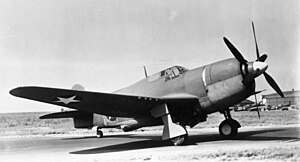Curtiss XP-62
This article includes a list of references, related reading, or external links, but its sources remain unclear because it lacks inline citations. (August 2024) |
| XP-62 | |
|---|---|
 A Curtiss XP-62 on the tarmac | |
| General information | |
| Type | Fighter interceptor |
| Manufacturer | Curtiss-Wright |
| Status | Cancelled 21 September 1943 |
| Primary user | United States Army Air Forces |
| Number built | 1 |
| History | |
| Manufactured | 1943 |
| First flight | 21 July 1943 |
The Curtiss XP-62 was a prototype single-engine interceptor aircraft, that was built for the United States Army Air Forces, by the Curtiss-Wright Corporation. It first flew in 1943.
The design sought to have an improved high-altitude performance and higher speeds, at all altitudes, which was to be assisted by the 18-cylinder Wright R-3350 Duplex-Cyclone engine.[1] It was to be armed with four 20 mm (0.79 in) autocannons, a heavier armament than contemporary USAAF fighter aircraft, and was fitted with a pressurized cockpit.
Design and development
[edit]The terms of the contract proposal of 29 April 1941 called for the first flight within fifteen months of the award and meet the following objectives.
- Maximum level flight speed at 27,000 ft (8,200 m) had to exceed 468 mph (753 km/h).
- It was to feature an air-conditioned pressurized cockpit.
- Armament to be either eight 20 mm (0.79 in) cannons or twelve 0.50 in (12.7 mm) machine guns, mounted in the wings.
Two prototypes were ordered; the first designated XP-62 and the second designated XP-62A.
On 2 August 1941, the specifications were amended for the XP-62, reducing the maximum speed to 448 mph (721 km/h) with eight 20 mm (0.79 in) cannons, and increasing the loaded weight by 1,537 lb (697 kg).
During a project review of 1 January 1942, the specification was again revised, with the loaded weight reduced by eliminating four cannons and removing the propeller de-icing equipment.
On 25 May 1942 a contract for 100 P-62 fighters was awarded. However, on 27 July 1942, before production could begin, the contract for the P-62 was terminated by the USAAF because of the effect on deliveries of Curtiss-built Republic P-47G-CU Thunderbolts.[1]
While work on the XP-62A continued, it progressed slowly, owing to its low priority. Delays in delivery of the pressure-cabin supercharger and engine modifications delayed the first flight until 21 July 1943. Only a limited amount of flight testing was carried out before the XP-62A was canceled on 21 September 1943 and full performance characteristics were not obtained. The prototype was scrapped in early 1944.
Variants
[edit]- XP-62
- Prototype, 8 x 20 mm cannons
- P-62A
- Planned initial production version, 100-aircraft contract cancelled
Specifications (XP-62)
[edit]Data from Curtiss Aircraft 1907–1947[2]
General characteristics
- Crew: 1
- Length: 39 ft 6 in (12.04 m)
- Wingspan: 53 ft 8 in (16.36 m)
- Height: 16 ft 3 in (4.95 m)
- Wing area: 420 sq ft (39 m2)
- Airfoil: root: NACA 66-118; tip: NACA 66-113[3]
- Empty weight: 11,775 lb (5,341 kg)
- Gross weight: 16,650 lb (7,552 kg)
- Powerplant: 1 × Wright R-3350-17 Duplex Cyclone 18-cylinder air-cooled radial piston engine, 2,300 hp (1,700 kW)
- Propellers: 6-bladed contra-rotating constant-speed propeller
Performance
- Maximum speed: 448 mph (721 km/h, 389 kn) at 27,000 ft (8,200 m)
- Range: 1,300 mi (2,100 km, 1,100 nmi)
- Service ceiling: 37,500 ft (11,400 m)
- Time to altitude: 15,000 ft (4,600 m) in 6.9 minutes
- Wing loading: 35 lb/sq ft (170 kg/m2)
- Power/mass: 0.16 hp/lb (0.26 kW/kg)
Armament
- Guns: 8 x 20 mm (0.787 in) cannon
See also
[edit]Related lists
References
[edit]- ^ a b "Curtiss XP-62". National Museum of the U.S. Air Force. 2009. Archived from the original on 10 October 2012. Retrieved 2 September 2024.
- ^ Bowers, Peter M. (1979). Curtiss aircraft, 1907-1947. London: Putnam. pp. 327–331. ISBN 0370100298.
- ^ Lednicer, David. "The Incomplete Guide to Airfoil Usage". m-selig.ae.illinois.edu. Retrieved 16 April 2019.
- Green, William. War Planes of the Second World War – Fighters, Volume 4. London: Macdonald. 1961.
External links
[edit]- Curtis XP-62 – National Museum of the USAF
- Wind-Tunnel Tests Of The 1/9-Scale Model Of The Curtiss XP-62 Airplane With Various Vertical Tail Arrangements – DTIC
